|
BMW Suspension Basics
Suspension Basics for BMW 1/2/3/4-series Models, including M Models
This page applies to BMW models: E82, F22, F87, E36, E46, E90, E92, E93, F30, F31, F36, G20, F80, F32, F33, F34, G22, F82, F83, E85, E86Scratching your head on BMW suspension types, options, and opinions? We all were at one point. This page is a "Suspension 101" introduction to suspension layouts, terminology, and types for BMW enthusiasts. You won't find our recommendations here (see links at the bottom) as this page exists to educate and inform. Near the bottom you will find a "Pictionary" style glossary of BMW suspension components.
It's impossible to cover all types of BMW suspensions on a single web page. Books devote whole chapters to each model. We're going to cover the basics in a very generalized way to get you acquainted with BMW suspensions. Our focus will mainly be on 1992-2005 BMW 3-series and 2006+ 1/2/3/4-series models.
What you will notice most is that rubber bushings are everywhere in a BMW suspension. Some use a hybrid fluid and rubber bushing design called a hydrobearing. Rubber is an excellent choice for a suspension bushing - if you're selling millions of cars. It's cheap, easy to produce, comfortable, reacts quickly, resistant to chemicals and moisture, requires no maintenance, can be made in any shape, and the rubber compound can be tailored for each application. The BMW ride and handling is so often celebrated because of the rubber bushings in the suspension but it's a compromise. The suspension tuning must live up to the "Ultimate Driving Machine" reputation but also appeal to a ever-increasing consumer audience. Consequently the bushings and suspensions have gotten softer. One complaint we often hear is that BMWs have become too soft but that's the trade-off BMW made to sell more cars. Besides, it's easy to change a bushing to make the car more responsive and sportier.
1992-2006 3-series, 2003-2008 Z4
E36 (except 318ti), E46 3-series, including M3 models, E85/E86 Z4)
The front suspension was basically carried over from the E30 3-series models, using a single boomerang-shaped control arm and MacPherson strut. The rear changed from a simple trailing arm per side to a more complex "Z-link" rear suspension anchored by a large semi-trailing arm and upper and lower link per side. Trivia fact: this rear suspension was originally developed on the Z1 roadster.
Front Suspension
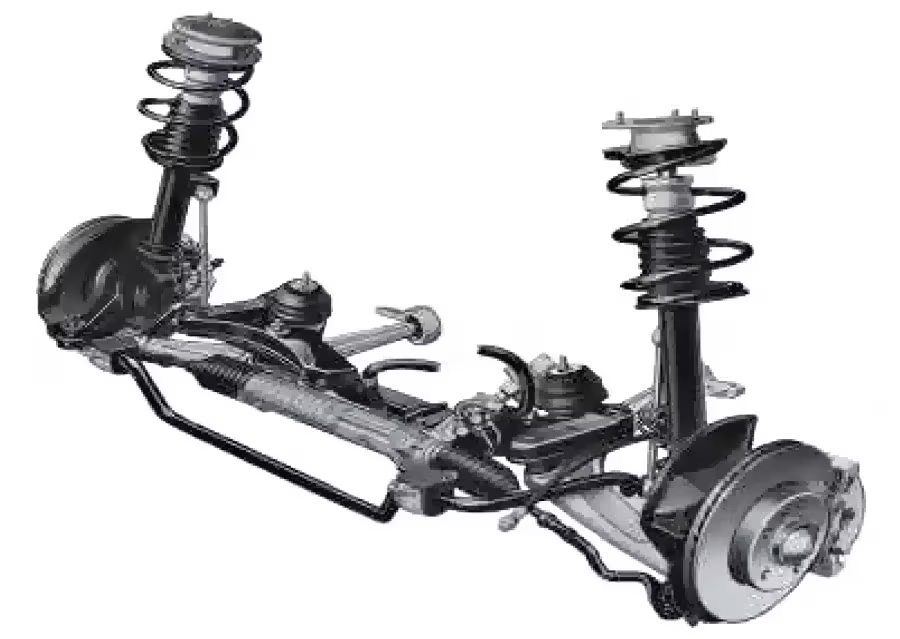
BMW Single Pivot front suspension on E30, E36, E46, Z3, & Z4.
(image shows early version of E46 front control arm)
Strut: MacPherson design, "coil over" spring on the strut housing with a large upper rubber-isolated mount. The strut assembly (strut + spring) is bolted or clamped to the spindle. Springs do not typically wear or sag but the strut will get worn out and no longer hold pressure. The strut can be replaced but the entire assembly must be taken apart. Always get new mounts, bump stops, and spring pads. Reinforcement plates exist for the sheetmetal where the strut is mounted and they are strongly recommended.
Control Arm: often called a wishbone in BMW parts diagrams but looks more like a boomerang. It contains two ball joints: an outer at the spindle and an inner attached through the front subframe. A rubber bushing locates the arm to the frame rail. Ball joints wear quickly and can be a safety concern. The rubber bushings get too soft, leaving the steering and handling mushy and no longer as precise as it used to be.
Sway Bar: located under the front frame rails and engine bay with rubber bushings. The ends are attached either to the control arms or to the strut housing. The links contain ball joints that are a known source for rattles and clunks.
Rear Suspension
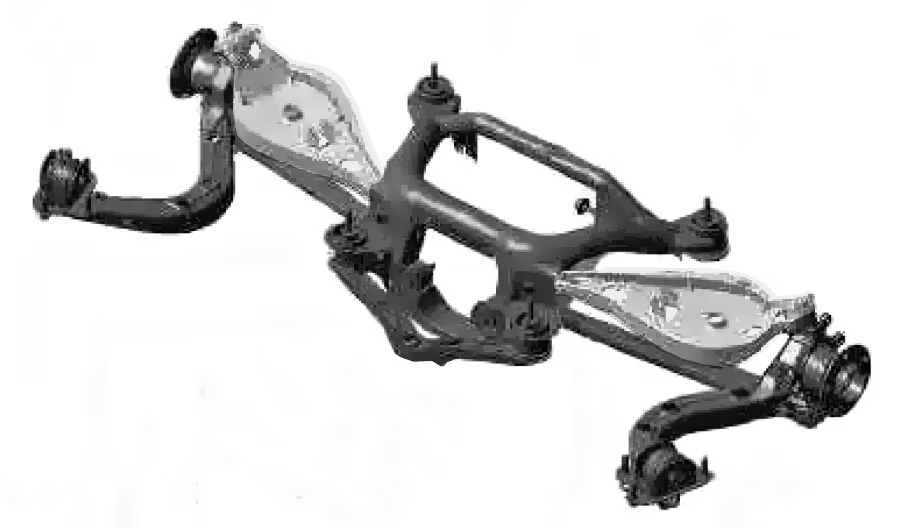
BMW Central C-link rear suspension on E36, E46, E85, and E89 (internal code HA3).
Shock: a single shock on each side is bolted to the spindle at the bottom and through the body with a rubber mount at the top. Shocks typically last a long time but can wear out and no longer hold pressure. Unlike the front strut, the shock can be replaced on its own with minimal disassembly. The shock mount, on the other hand, is a very common failure point and may need to be replaced before the shock wears out. There are several shock mount upgrades that last longer. Reinforcement plates exist for the sheetmetal where the shock is mounted and they are strongly recommended.
Subframe: the entire rear suspension and differential, apart from the shock, is anchored by a steel subframe bolted to the trunk floor. The floor area itself is weak and cracks in the sheetmetal are common. Reinforcement plates exist for the sheetmetal and they are strongly recommended.
Semi-Trailing Arm: the other major component in the rear suspension. The semi-trailing arm, or just trailing arm, provides the outer mounting point for the axle shaft, upper and lower control arms, shock absorber, as well as the brake assembly. It's mounted at the front using a rubber bushing recessed into a pocket in the chassis (under the rear seat). The back of the trailing arm contains upper and lower bushings (or sealed bearings) and the axle. The forward bushings are common wear items leading to loose or "squirrely" handling. The rear upper and lower bushings are either rubber and will wear out or a innovative sealed ball joint that lasts a long time. The seal ball joint can be used as an upgrade over its rubber counterpart.
Upper Control Arm: used to locate the spring. It attaches to the subframe on the inside with a rubber bushing and to the trailing arm with a sealed ball joint.
Lower Control Arm: also called a wishbone by BMW (quite accurate) or the camber arm as it's used to set the camber alignment on the rear. Also mounted with a rubber bushing on the inside or a rubber bushing or sealed ball joint on the outside. These arms are made from thin steel and are designed to bend easily to prevent damage to the rest of the suspension. If you have trouble getting the alignment in spec or the car sits differently on one side, it could be from a bent lower arm. It's also common to replace this with a fully-adjustable arm to gain more negative rear camber.
Sway Bar: runs around the back of the subframe and differential, mounted with rubber bushings, with links attaching the bar ends to the upper control arm.
2006-current 1/2/3/4-series
E82 1-series, F22 2-series, E9X 3-series, F30 3-series, G20 3-series, F32 4-series, G22 4-series, including 1M/M2/M3/M4 models, G29 Z4
A massive change to the suspension layout occurred for the 2006 model year. The E90 3-series adopted the same suspension design as 5/6/7-series models, although no parts are shared. The front now used two control arms per side along with a MacPherson strut. The rear dropped the massive semi-trailing arm in favor of multiple smaller arms still attached to the rear subframe. The suspension layout is still in use today on the very latest G20 3-series and G22 4-series models (although parts are not interchangeable).
Front Suspension
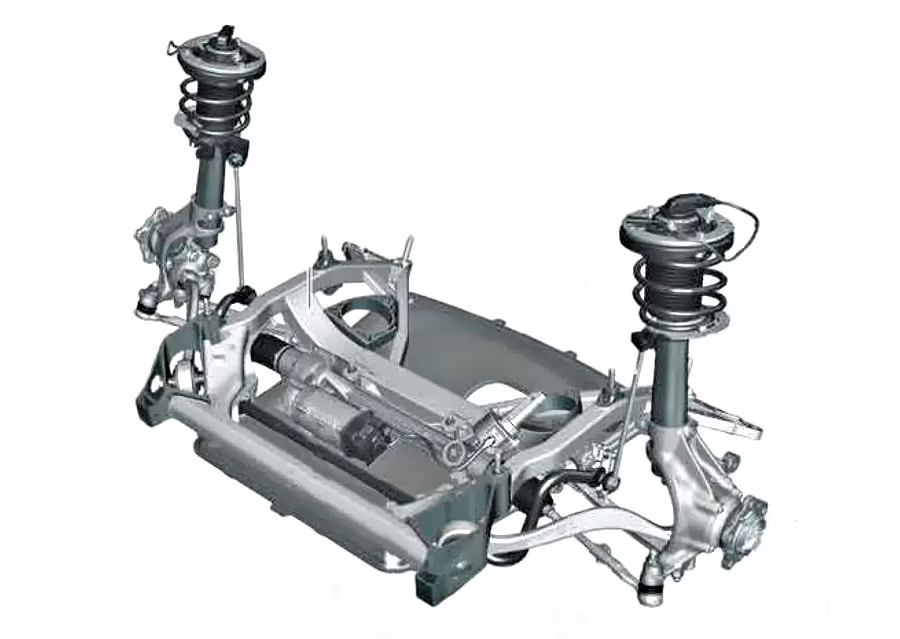
BMW Double Pivot front suspension.
Strut: MacPherson design, "coil over" spring on the strut housing with a large upper rubber-isolated mount. The strut assembly (strut + spring) is clamped to the spindle. Springs do not typically wear or sag but the strut will get worn out and no longer hold pressure. The strut can be replaced but the entire assembly must be taken apart. Always get new mounts, bump stops, and spring pads.
Upper Control Arm (aka Thrust Arm or Tension Strut): this arm is mounted ahead of the lower arm, and the outer ball joint points down. The arm is not straight and has several bends in its shape. The dual front control arms do a better job of controlling wheel motions during cornering and when the suspension compresses. The upper arm absorbs most of the impacts and vibrations as the suspension moves. The inner bushing can be a weak point as it's filled with a dampening fluid that can leak or evaporate. With no strength in the bushing the ride and handling quickly deteriorate. There's no way to refill the fluid so the complete bushing needs to be replaced. The M2/M3/M4 models use a non-hydro bushing that can be used as an upgrade.
Lower Control Arm (aka Wishbone): this arm sticks straight out from the front subframe. The arm itself is straight but will have a slight upward curve. The outer ball joint points up. The arm's principle purpose is to control camber change as the suspension compresses. It has a sealed inner ball joint that almost never wears out.
Sway Bar: located under the front frame rails and engine bay with rubber bushings. The ends are attached either to the control arms or to the strut housing. The links contain ball joints that are a known source for rattles and clunks.
Rear Suspension
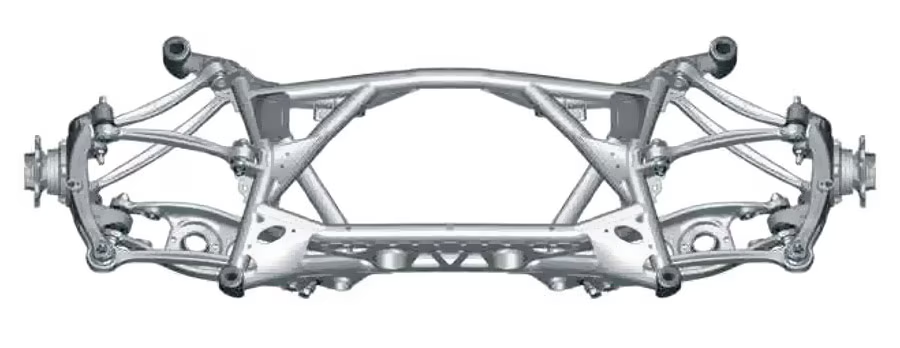
BMW 5-link rear suspension (internal code HA5).
Shock: a single shock on each side is bolted to the lower arm and through the body with a rubber mount at the top. Shocks typically last a long time but can wear out and no longer hold pressure. Unlike the front strut, the shock can be replaced on its own with minimal disassembly.
Subframe: the entire rear suspension and differential, apart from the shock, is anchored by a steel subframe bolted to the trunk floor. Unlike the previous designs, there are no issues with the rear floor cracking. The subframe mounts are a soft-ish rubber compound that are often replaced with a urethane or aluminum mount that does not flex as much.
Control Arms: this suspension uses five (5) rear control arms. More arms means the suspension motion and load is spread over a larger area, which means less wear and tear and better control. There is no longer a central semi-trailing arm but there is a main arm that BMW calls a "roll-over strut". The shock and spring are both located on this lower arm. All of the arms are mounted to the spindle and to the subframe using rubber bushings. The M2/M3/M4 models use the sealed ball joint design and most of those arms can be used to upgrade the non-M models. This is especially important on high-horsepower tuned turbo models where the original rubber bushings allow too much twist, deflection, and axle hop during acceleration.
Sway Bar: located over the subframe with rubber bushings. The ends are attached to the "roll-over strut" lower control arm. The placement of the bar on top of the subframe makes it challenging to remove for an upgrade but it can be done while doing other related work.
A Pictorial Glossary of BMW Suspension Terms (a "Pictionary")
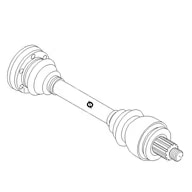 Axle | Part of the driveline. It's a shaft extending from the differential to the spindle and hub. They are more commonly known as half-shafts or axle-shafts. The "axle" may also refer to the complete front or rear suspension, encompassing the shocks, control arms, bushings, sway bar, half-shafts, spindle, and even inclusive of the brakes. |
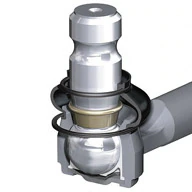 Ball Joint | An internal suspension component consisting of the a steel ball encased in a metal, plastic, or rubber isolated cup and with a threaded stud for mounting. The ball is able to rotate within the cup and allow the suspension component to change direction. Ball joints are typically mounted to allow horizontal movement (side to side). They are a common wear item as the internal plastic or rubber isolator breaks down and can no longer contain the ball. |
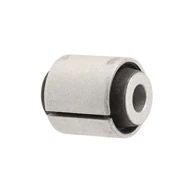 Bushing | Typically a formed rubber piece used to locate a component to another component. The sway bar is mounted to the body using a rubber block. Rubber is a favorite material (see paragraph above) but is often replaced with a stiffer rubber compound, urethane, Delrin, or even as rotating bearing. |
 Camber | The angle of the tire in relation to a flat Earth. BMWs have slight negative camber as a baseline - the top of the tire tilts inward. As the car corners the outside tire will spread flatter to the pavement, increasing its contact patch. It's common to add more negative camber to get more grip on the race track. Too much negative camber causes the tire to ride on its inside shoulder when going straight. |
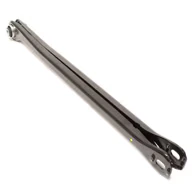 Camber Arm | A rear suspension component designed to control and/or adjust camber. On the E36/E46/Z4 it's the rear lower wishbone. It's made of sheetmetal and bends easily. It's designed to bend so that in an impact the arm takes all the energy and something else isn't damaged. If you notice one side of the rear is a different camber or ride height check the lower camber arm. |
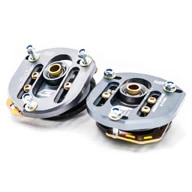 Camber Plate | A front suspension component designed to control and/or adjust camber. The camber plate often replaces the upper strut mount. More negative camber is desired for track use to improve front grip and reduce understeer. Lowered cars often need the negative camber reduced to correct for tire wear. So not all camber plates are the same. |
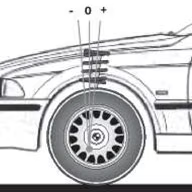 Caster | The rearward tilt of the front steering axis centerline, measured in degrees. The Caster is the degrees between a vertical line drawn straight up from the steering pivot point and the angle of the strut. BMWs have non-adjustable positive caster where the strut is angled backwards towards the driver. This increases stability at high speeds. Too much will make steering effort higher. |
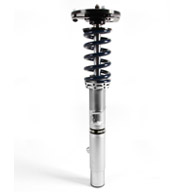 Coil-Over | A shock absorber with the spring mounted around the body of the shock. A MacPherson strut is technically a coil over. In the parts world, the term is reserved for performance shock and spring packages that have a threaded spring perch to allow ride height adjustments. |
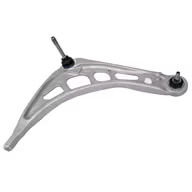 Control Arm | A suspension component designed to maintain the desired suspension alignment during suspension movement. It will also absorb vibrations and impacts with a bushing. Multiple control arms will do a better job of controlling alignment. |
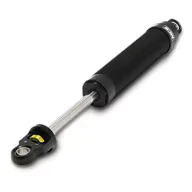 Damper | Another word for shock absorber or strut. Damper is a catch-all term that can apply to a front strut or rear shock. The damper's purpose is to control the motion of the spring and the rest of the suspension. The shock must be soft enough in compression to provide a comfortable ride but stiff enough in extension to keep the suspension from oscillating and keep the tire planted on the ground. |
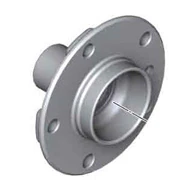 Hub | A solid surface for mounting the wheel. It's often used as a reference for the attachment of other components - "the strut is mounted to the hub". Used interchangeably with the spindle. |
 Hydrobearing | A rubber bushing that holds a thick dampening fluid to help absorb vibrations. Unfortunately, when the fluid is gone the remaining rubber bushing cannot properly dampen the vibration or control suspension motion. A clunk, rattle, or vibration will be felt. Fluid is a great damper of vibration but the bushing is not serviceable and it's easy for the fluid to leak or evaporate. Solid rubber or urethane are excellent alternatives. |
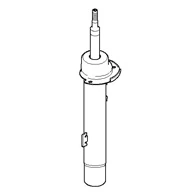 MacPherson Strut | A strut/damper design that acts as another link in the front suspension. This is different than a upper and lower control arm layout with a shock mounted independently from the arms. With a MacPherson design, the strut is an critical piece in the suspension assembly. With the strut mounted directly to the spindle the internal damper moves at nearly 1:1 ratio to the wheel. All BMW 1/2/3/4-series models use a MacPherson front strut. |
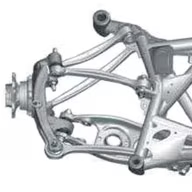 Multi-Link | A catch-all term for any suspension that has multiple control arms and attachment points to the chassis. The E9X rear suspension is known as a 5-link layout. |
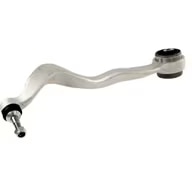 Radius Arm | Another BMW term for a control arm. It's most often used on front upper control arms. |
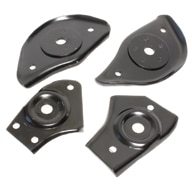 Reinforcement | A piece of sheetmetal, shaped to match the pattern and shape of an existing sheetmetal body piece that will add strength and rigidity. Unfortunately, some BMW models require extra reinforcement in suspension locations. |
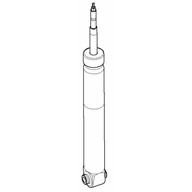 Shock | A rear suspension damper that slows and controls the coil spring. See "Damper" above. A shock differs from a strut because the it is not an integral part of the suspension. The control arms, spring, and hub could function without a shock (but you wouldn't want them to). |
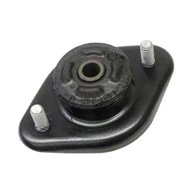 Shock Mount (RSM) | A rubber bushing used to mount the rear shock absorber to the chassis. |
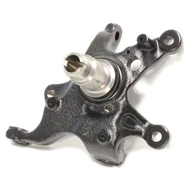 Spindle | A central mounting point for multiple suspension components, including the outer control arms and the lower strut mount. It also provides a mounting point for the wheel bearing, hub, and brakes. |
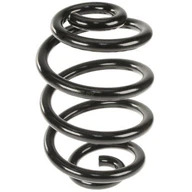 Spring | All BMWs use either a steel coil spring or an airbag. Springs come in different lengths and rates, depending on the model and included options. Ride stiffness most often comes from the spring rate so it's very easy to go too stiff and make the rest of the suspension ineffective. Too stiff and too soft will both negatively affect tire grip and handling but there is always a sweet spot. |
 Strut | A front suspension damper that slows and controls the coil spring. See "Damper" above. A "strut" differs from a shock because it carries the spring and has some load-bearing function. |
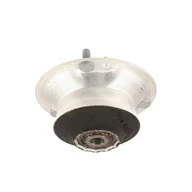 Strut Mount | A rubber bushing encased in steel or aluminum used to mount the front strut to the chassis. |
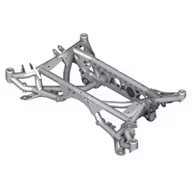 Subframe | A large steel or tubular structure bolted to the car's chassis and used to locate the rest of the control arms. The front also provides a mounting point for the engine mounts. The rear is also the mounting point for the differential and axle-shafts. |
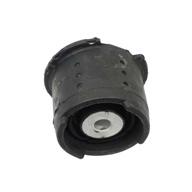 Subframe Mount | A dense rubber mount pressed into the subframe that provides isolation for the subframe, differential, and control arms. |
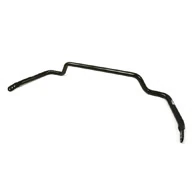 Sway Bar (Anti-Roll Bar) | A solid steel bar that counteracts the suspension motion during cornering. It acts as a lever - twisting as the suspension compresses. As one side compresses the bar twists to force the opposite tire to the pavement. The bar is mounted to the body of the car with rubber bushings |
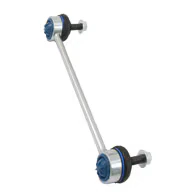 Sway Bar Link | The sway bar is attached to the suspension with a small arm called the link. A ball joint is located on each end and allows the link to rotate and move freely as the sway bar moves. |
 Tension Strut | Another BMW term for a control arm. It's most often used on front upper control arms. |
 Thrust Arm | Another BMW term for a control arm. It's most often used on front upper control arms. |
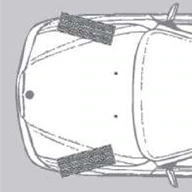 Toe | An alignment spec for the angle of the tire in relation to the centerline of the car. Toe is measured at the front/leading edge of the tire on the same axle. If the tires are pointing away from each other the toe is "out". When the tires point in towards each other, the toe is "in". Front toe adjustment is done via the tie rod. Rear toe is sometimes adjusted from either the trailing arm or a dedicated toe control arm. |
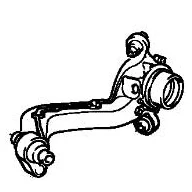 Trailing Arm | The principal control arm in the rear suspension. It's actually a semi-trailing arm because it's forward mounting point is ahead of the rear subframe. But it's shortened to trailing arm. On E36/E46 it's a huge steel piece and includes the rear spindle and hub. On later cars it's now much smaller and the spindle is separate. |
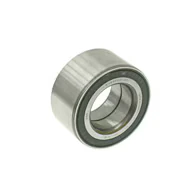 Wheel Bearing | A bearing used at each hub and allows the wheel and brake rotor to spin. The bearing is often pressed into the hub, which is then bolted or pressed to the spindle. |
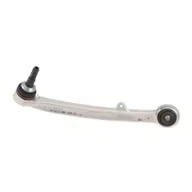 Wishbone | Another term for a control arm. It's used on the front as the "lower control arm" and on the rear in multiple points. It's a wishbone because it has three mounting surfaces - one at an end and two at the opposing end. |
Read more...
1. BMW Street Suspensions - our recommendations for suspensions used exclusively on the street (click here).
| Sort by Name | Sort by Price |

